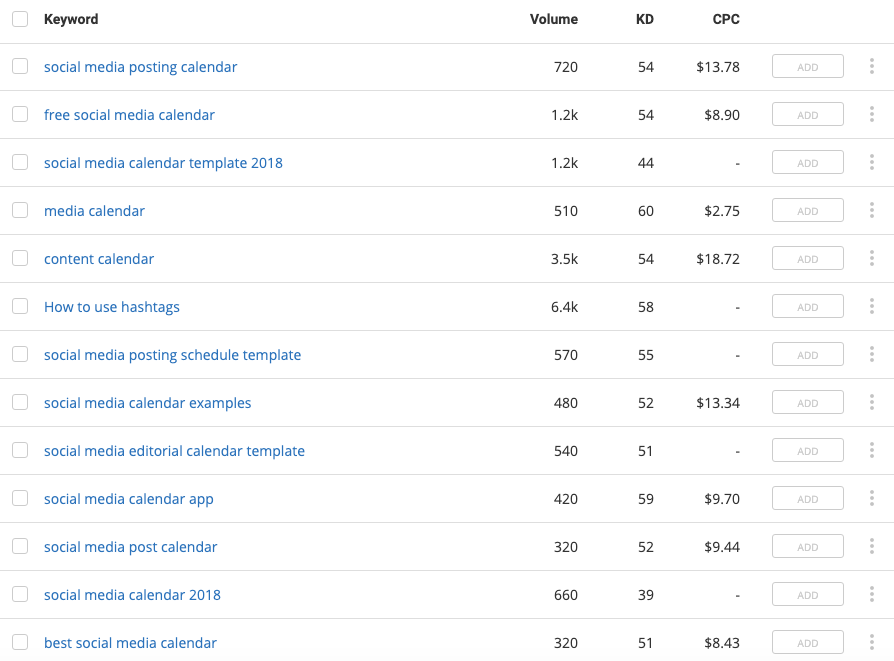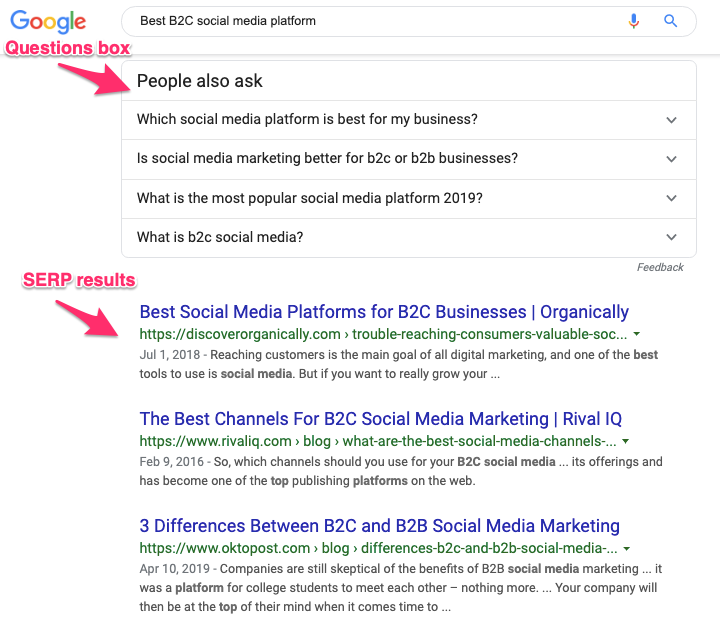Targeting the wrong keyword in your article or on your landing page is a disaster. No matter how much traffic you bring in by ranking, it won’t matter. That’s what makes keyword research so important. When you understand your target personas—their wants, their needs, the intent behind their search—you’re able to increase traffic that’s relevant to your business and your goals.
Combine that with the knowledge of how search engines work, and you’re setting yourself up to find the most relevant and high-quality leads possible.
Thinking about the underlying factors that make a keyword good or bad also helps you prioritize the way that you research, creating a framework that’s efficient and repeatable.
First, come up with a list of topics that are relevant to both your customers and your prospects. Then figure out exactly what kind of searches those people do to find more information. From there, you can start thinking about targeting specific parts of the sales and marketing funnel and the different kinds of content you want to create.
In this article, we’ll talk through how you find the right kind of topics for your keyword list, break that list down into sections, nail down searcher intent, and figure out where each keyword fits into a larger SEO targeting strategy. From there, you’re off to the races, building out a keyword list that’s valuable for both your business and your customer.
1. Build a List of Relevant Topics
Before you jump into researching individual keywords, it’s important to think about the topics that are most relevant to your target customer. These are the general themes related to your business and your product. A SaaS pricing tool, for example, would look at topics like subscription revenue and churn.
This topic list will help focus your research and streamline the process for coming up with new keywords in the future.
The topics you identify could also be used as high-volume, high-difficulty keywords. When you’re thinking about a keyword strategy, figuring out the topics that can surface the most valuable keywords will help you prioritize your plan of attack. Understanding how topics and keywords relate to one another is paramount.

Get your keyword research started with high-level topics related to your market space. If you’re a B2C social media platform, include the following topics:
- publishing schedules
- content ideas
- reporting
From there, it’s easy to start building a word map of concepts that relate to your products and your customers’ problems. These sub-topics can be used as the jumping-off point for sourcing long-tail keywords in the future and help you create a framework for thinking about your company, your customer, and your market as a whole. Take the topic of publishing schedules, for example.
- publishing schedules
- creating a content calendar
- finding the right times to publish content
- tools for scheduling across different platforms
Use your customer personas to find out what different topics are relevant to each type of customer. Then, expand on these ideas by searching through social media feeds, reddit threads, forums, and Quora questions to see what your actual customers are talking about as well.
Get creative with this stage in your keyword research. Check out what your competitors are talking about, sign up for email newsletters about your industry, look at blog comments, and join professional networking groups (online or in-person). The more you know about what your customers are interested in, the more targeted your keyword topic list will be.
Just remember, at this point, your only goal is coming up with enough topics to facilitate better keyword research in the future. Don’t think about whether or not there’s enough volume or anything like that. All that matters is whether or not the topic is relevant to your market, your company, your product, and your customer.
2. Refine Topics into Keywords
Once you have a substantial topic list, around 20 is good to get started, split it up into sections based on the types of content you can create. From there, you can break down each topic into a list of relevant and valuable keywords by thinking about what kind of content you want to use the keywords for. Some topics will lend themselves more to social media posts, while others will be suited for long-form blog posts.
At this point, you’re really just putting down words on a page; the more keyword ideas you have for any given topic, the better.
Then, refine your list using one of the various keyword tools available, each with a suite of features that help expand on any topic or keyword you define at the start. Using our example from earlier, let’s take a look at some of the keywords you could use for the social media calendar:

As you can see, the variety of keywords all revolve around the exact words we used in our original keyword. If we expand on this list to include "Also ranks for" data, here’s what we see:

The first 10 or so items on this list were the same as those suggestions in “Similar Keywords,” but now we’re seeing long-tail variations that don’t include the same exact keywords.
You can gain some advanced insights through this video. Learn how to work with each of the keyword sections (similar, also ranks for, questions people ask, and transactional keywords) and incorporate the results into your research.
Using this data, as well as Google SERP results, AnswerThePublic, and a myriad of other sources, you can start compiling a list of keywords that not only relates to your topic but also has the search volume and difficulty that is attainable for your business.
Once you’ve built your general keyword list, it’s time to move forward with refining it even further based on searcher intent and funnel location. That process of winnowing down your primary list makes it easier to create targeted content with real ranking potential.
3. Nail Down User Search Intent
Search intent is one of the most important aspects of keyword research. Understanding the purpose behind why a potential customer is searching for information is the best tool you have for creating content that solves their problem. If you’re not thinking about the intent behind every keyword you target, it’s possible to invest a lot of effort into creating a piece of content that ranks well for a particular keyword without actually solving the specific kind of problem the search was looking for.
The first step is to figure out what someone searching for your topic is actually looking for. Someone searching for reporting on Facebook likely won’t be interested in the same type of information as someone searching for Facebook reporting template.
Intent can be broken down into four general categories.
Informational Intent
Informational searches occur when the user is interested in learning more about a specific topic. Often framed as a “how” question, these keywords are very useful for creating targeted content on your blog. Going back to our B2C social media platform example, some informational searches might be:
- How do I build a social media calendar
- Creating copy for Facebook ads
- Best times to post on Twitter
For each of these topics, the searcher is looking for educational material. Our example company could easily use this information to create an article, or series of articles, that breaks down the best practices and strategies a user needs to accomplish a specific task.
Transactional Intent
Transactional searches are a bit more narrow than informational searches. When a user performs this kind of search, they have a specific goal they want to accomplish right away. These types of keywords are better suited for landing and product pages. Potential examples from our fictional B2C social media platform:
- B2C social media platform cost
- Create Twitter business account
- Report Facebook ad
Each of these topics has a definite end state: finding out the price of a tool, creating a business account, reporting an ad. When you’re targeting these types of keywords, it’s important to provide a solution as quickly as possible.
Commercial Intent
Taking transactional intent a step further, commercial intent includes searches where the user wants to buy something. These are great keywords for targeted ads and product pages. Let’s say that our B2C social media platform has three pricing tiers and several upgrade paths; then searches might look something like this:
- Best B2C social media platform
- Create B2C social media platform account
- Upgrade to feature X
When someone is searching for one of these topics, they’re actively seeking out a way to convert. Make sure you’re only targeting these keywords, so you make that conversion easy.
Navigational Intent
Navigational intent refers to searches where someone wants to locate a specific page or piece of information. You should include these keywords on your landing and login pages. Some examples might include:
- B2C social media platform login
- Contact email for X
These keywords aren’t as important for your content creation or ad-targeting strategies; remove them early on to refine your keyword list.
When you understand the intent behind different kinds of searches, it’s easier to split up your topic list for further keyword research. Depending on the campaign you’re doing research for, each of these keyword intent types will have a specific priority. If you’re targeting someone who’s just finding out about your service, informational intent keywords are your #1. By creating content that educates potential customers, you’re building trust in your brand and subject matter expertise.
If you’re targeting someone further along the buyer’s journey, transactional or commercial keywords are going to be better options. Combine this with an understanding of how intent changes as people move further down your sales and marketing funnel, and you can create a keyword list that’s targeted specifically to each step along the way.
4. Target a Specific Part of the Funnel
The types of keywords someone uses when they’re at the top of the funnel will be very different from what they use at the bottom. Knowing where specific keywords fall in the marketing funnel not only informs the kind of content you need to create, it also helps you refine the overall searcher intent.
A great way to frame your keyword research for this is by thinking about the type of campaign you’re planning to run with these keywords and moving forward from there.

If you’re thinking about a traditional sales funnel (like this one from Zendesk) Sell, Awareness and Interest are at the top, Evaluation and Engagement in the middle, and Purchase at the bottom. Let’s start from the top!
Top of Funnel Keywords
These are the broadest keywords to include in your research. They’re meant to attract interested searchers to your website, where you can provide relevant answers to their questions. Targeting the right keyword can help you move someone who’s just become aware of your company to someone who’s interested in learning more about what you have to offer.
Think about these types of keywords as your first impression. Your main goal is to provide something of value and start the relationship with a potential customer off on the right foot.
Middle of Funnel Keywords
For the middle of the funnel, you want keywords that are a bit more specific than ToFu keywords. The goal here is to foster a relationship between you and the searcher. At this point in the funnel, a user is already interested in what you have to offer and is in the process of evaluating whether or not it’s right for them.
Look for keywords that not only bring in more traffic but are also targeted to aspects of your product or service that you know the search will find valuable. Associating your company with the value it provides can help trigger engagement, whether that’s in the form of a free trial, a request for more information, or a simple newsletter signup.
Bottom of Funnel Keywords
These are the keywords that help you convert people into customers. When you’re researching keywords for BoFu customers, promoting your product or service as the answer to a specific problem is the key. BoFu will likely include your product name and branded keywords. At this point, people know who you are and are actively seeking out more information.
Look for keywords that show commercial intent. Combining commercial keywords with those at the bottom of the funnel makes setting up a conversion path that much easier.
With this information in hand, now’s your opportunity to get a bit more granular into how keyword research impacts the physical search results. What kind of features are you going after? What does the SERP look like? Understanding this is key to creating content that actually ranks.
5. Go After Relevant Search Features
Google surfaces different types of results for any search. From text and rich media to Knowledge Graph and carousel results, understanding what search features are included when people search for your keyword helps you create content with more ranking potential.
These features are, however, a double-edged sword. Ranking in the image pack or carousel may pull traffic away from your page by providing all the requisite information a user needs up front, but a featured snippet can be more enticing for users. When you’re performing keyword research, it’s important to actually go out there and interact with the SERP. There’s no better way to gain insight into how potential customers will interact with your content on the page.
Let’s take a look at this in action on the Google results page for an informational intent search:

In this example, we see some fairly standard SERP features—including an ad, feature snippet, and true result. We can really see how intent factors into the results here as well, with Google pulling structured data from the SERP result it finds most valuable. What’s interesting is that this featured snippet is displaying the steps outlined for building a social media content calendar in the first real SERP result. Just note that this won't always be the case; featured snippets may not always pull from the first real result.
For Hootsuite, then, the search feature is potentially more valuable. It gives potential readers a peek at what they’ll be able to learn by clicking through to the content without giving away too much information.
The ad from Smartsheet makes a lot of sense as well because their platform is built to facilitate cross-functional team calendars.Now, let’s take a look at the results for a commercial intent keyword:

In this example, Google could potentially pull traffic away from the ranking results by including the Questions feature on the page. Each question is a variation of the original search query and includes a link to another article that targets the question instead of the keyword.
These situations are why it’s so important to understand search features when performing keyword research. If there is potential for a search feature to pull attention away from the ranking results, you need to know. Whenever you’re getting started with keyword research, make sure you’re performing an actual search of the keyword to see how search engines structure the results. Understanding that will make it easier to create content with ranking potential.
Keyword Research Is Just the First Step
Keyword research is an ongoing process. Every keyword you target needs to be evaluated to ensure it’s consistently providing value to your strategy. This is much simpler when you’ve organized your keyword research by topic, intent, and funnel location.
When you follow these steps to frame the way you think about keyword research before jumping in, you’re setting yourself up to build the best possible version of a targeted keyword list.

